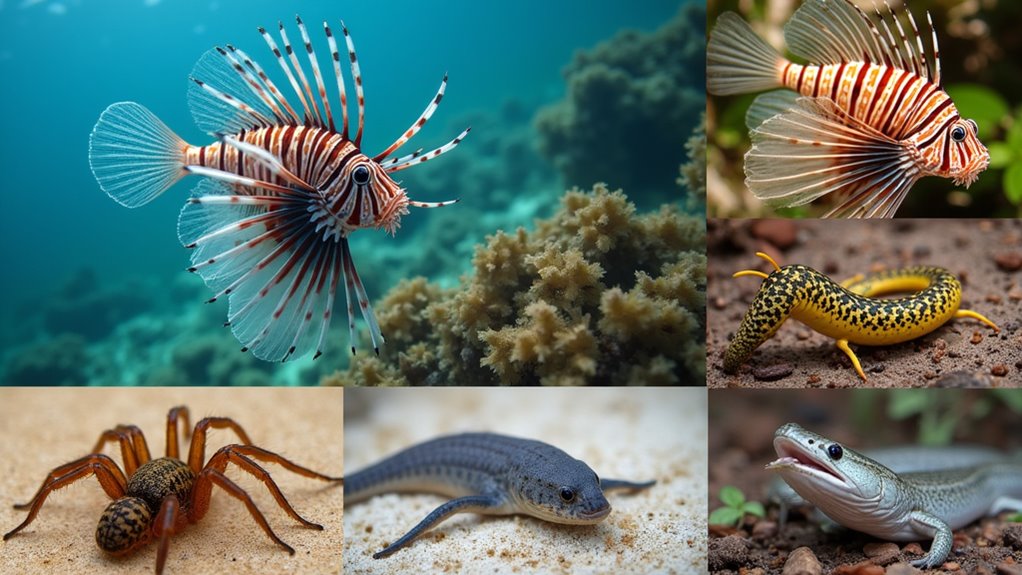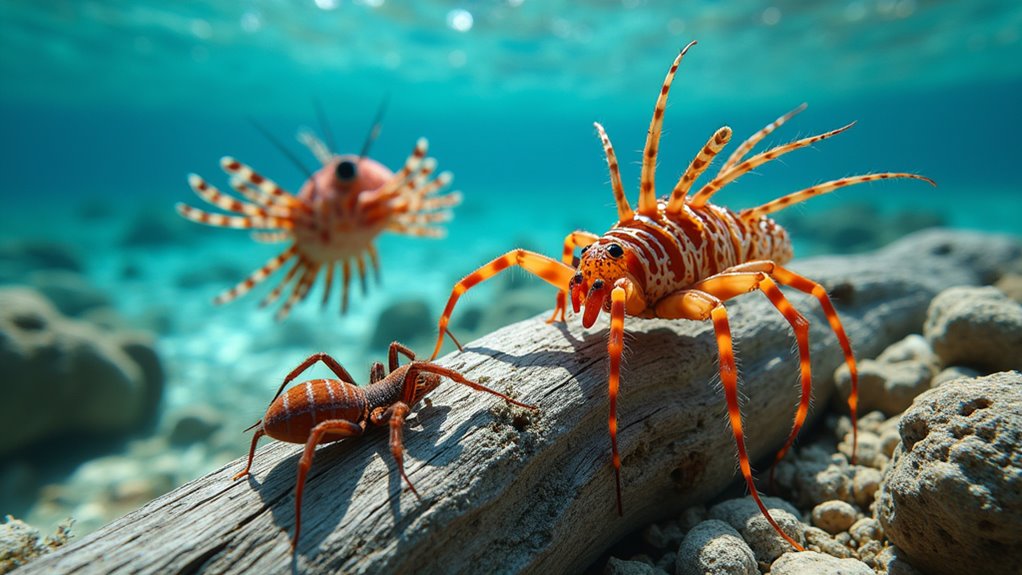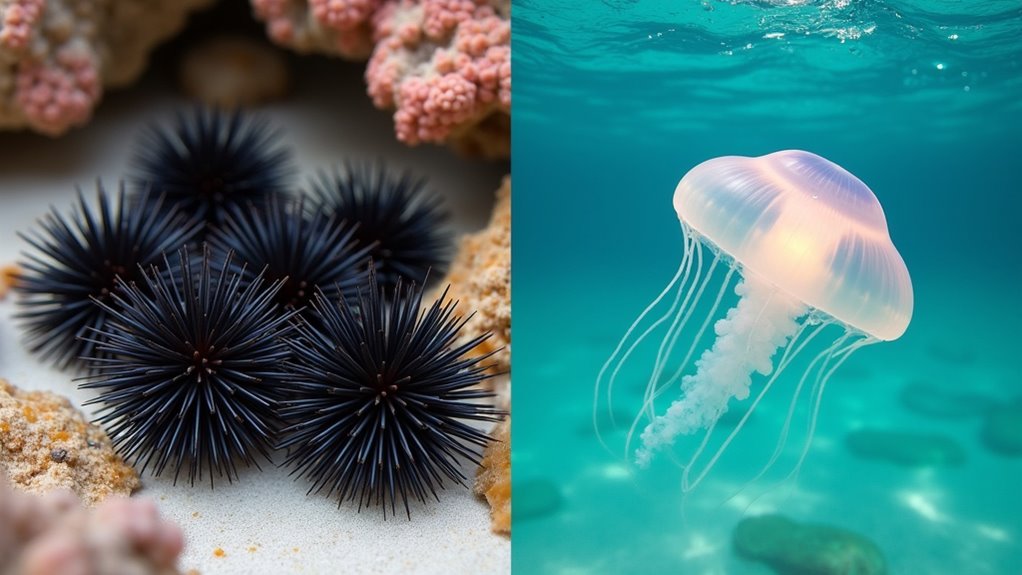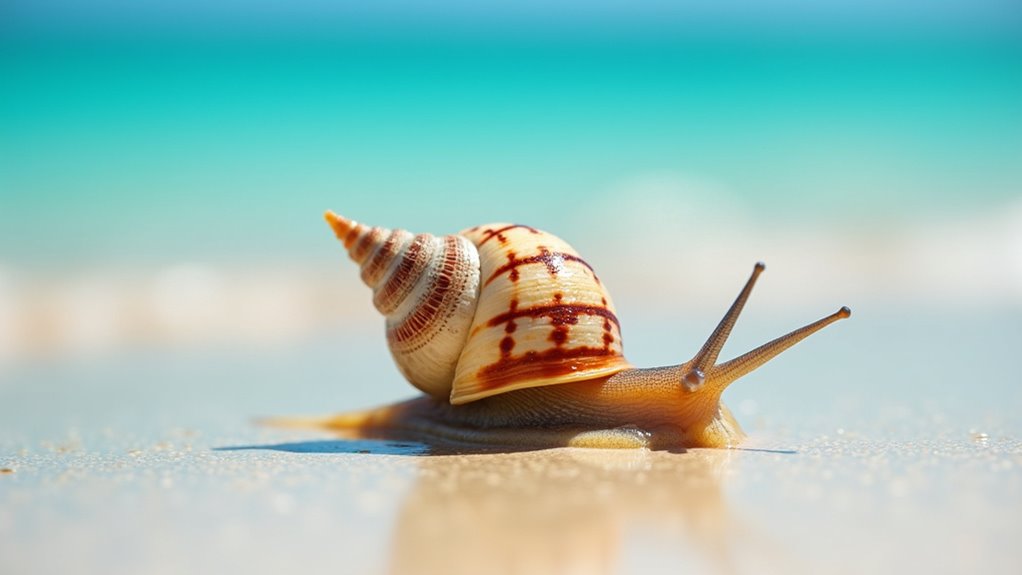Physical Address
304 North Cardinal St.
Dorchester Center, MA 02124
Physical Address
304 North Cardinal St.
Dorchester Center, MA 02124

Mesmerizing but menacing, Barbados harbors seven surprising creatures that could turn your island paradise into an unexpected adventure.
While Barbados is relatively safe wildlife-wise, you’ll still need to watch for several potentially dangerous creatures. The island’s waters harbor venomous lionfish, painful sea urchins, and Portuguese man-o-war jellyfish. On land, beware of territorial green monkeys, painful centipede bites, and beautiful but deadly cone snails along shores. Within wildlife reserves, powerful pythons are handled under strict protocols. Understanding these local hazards guarantees your tropical paradise experience stays pleasant and incident-free.

Barbados is prominent among Caribbean destinations for its remarkable safety regarding dangerous wildlife. Unlike many tropical locations, the island lacks venomous snakes and dangerous spiders, making it exceptionally visitor-friendly.
Barbados stands out in the Caribbean for its wildlife safety—explore freely without concerns about venomous creatures.
The most concerning wildlife you might encounter are centipedes, which hide in dark, damp areas and can deliver painful (though rarely dangerous) bites if disturbed.
Pythons exist only in controlled environments like wildlife reserves, never in the wild. Even the spider population poses minimal risk, with no dangerous species native to the island. Many travelers who typically pursue surf destinations like Hawaii or Bali appreciate Barbados for its wildlife safety in addition to its beautiful beaches.
This natural safety extends to snakes as well—Barbados is completely free of venomous species. The Barbados threadsnake and other non-venomous varieties present zero threat to humans, letting you explore the island with confidence. The island’s popular Green Monkeys are rarely aggressive toward humans unless they feel threatened or cornered.
While the absence of dangerous land animals makes Barbados seem like a wildlife paradise, beneath its crystal-clear waters lurks the island’s most concerning creature: the red lionfish. First spotted in Barbadian waters at the end of 2011, this invasive species has rapidly multiplied, causing significant ecological damage. Following these initial sightings, local divers and fishermen have played a crucial role in documenting their spread throughout the island’s coastal areas.
The lionfish poses threats to Barbados in three key ways:
You’ll find lionfish in various habitats from shallow coastal waters to deeper reef zones. Barbados encourages eating lionfish as part of management efforts to control their spreading population.

Among the wildlife you’ll encounter in Barbados, green monkeys stand out as both fascinating and potentially problematic. These primates live in hierarchical social groups of 10-30 members and have adapted well to the island’s tropical forests.
While they’re typically non-aggressive when foraging, green monkeys can become territorial and defensive when they feel threatened. Their interactions with travelers have increased as human development encroaches on their habitat. Originally brought to Barbados from West Africa over 350 years ago, these monkeys have become deeply integrated into the island’s ecosystem.
You’ll often spot them near tourist areas searching for food, which has altered their natural behaviors. Unlike dangerous wildlife in other regions, these monkeys rarely cause serious injuries but can be intimidating when provoked.
Don’t be fooled by their adorable appearance – these animals can become aggressive when competing for resources or defending their territory. If you encounter them, maintain a respectful distance and never feed them, as this reinforces problematic behaviors and disrupts their social dynamics.
Lurking beneath the picturesque foliage of Barbados, centipedes represent one of the island’s most uncomfortable wildlife encounters. These “forty leg” creatures can grow up to 8 inches long and deliver a painful bite with their venomous front claws.
If you’re exploring the island, be aware that these quick-moving arthropods:
While rarely life-threatening, an encounter with the Barbados Giant Centipede (Scolopendra angulata) is something you’ll want to avoid. The distinctive physical features of this species make it easily identifiable to naturalists and researchers studying Caribbean arthropods. Unlike the peaceful island of Lanai, Barbados requires visitors to be vigilant about these creepy crawlers during outdoor adventures. Always wear protective clothing when gardening and check your shoes before putting them on.

Barbados’s crystal-clear waters hide dangers beyond the land-dwelling centipedes. Sea urchins, with their sharp spines and mild poison, lurk near coral reefs and rocky seabeds. Stepping on one causes painful punctures, with spines potentially breaking off in your skin. These spines typically release a deep purple dye and will naturally dissolve within days if left in the wound.
More notorious are the jellyfish, particularly the Portuguese man-of-war. Their nearly invisible tentacles can extend 165 feet, delivering painful stings that cause red welts, blisters, and occasionally severe allergic reactions. Even dead specimens washed ashore remain dangerous. Visitors should exercise extreme caution when swimming in areas known for dangerous marine wildlife.
If stung, rinse the area with vinegar and remove any remaining tentacles. For sea urchin injuries, soak in hot water to reduce pain. Always seek medical attention if you experience breathing difficulties, severe pain, or signs of infection after any marine encounter.
When visiting the Barbados Wildlife Reserve, you’ll encounter powerful pythons kept in secure enclosures designed for both their welfare and visitor safety. These impressive constrictors, some reaching lengths of 20 feet, display iridescent skin that shimmers with rainbow hues in the sunlight.
The reserve’s pythons, originally acquired from institutions like Ravensden Zoo in the UK, serve important ecological and educational roles. One notable resident, Lemon the python, was a main attraction at the reserve since 1983. You can observe them safely from designated viewing areas while learning about their natural behaviors. Unlike the tiger sharks commonly found in Hawaiian waters, these pythons pose minimal risk to humans when properly managed.
During your visit, you’ll discover:
The pythons contribute to the reserve’s mission of wildlife conservation and public education about Caribbean biodiversity.

Among the most dangerous creatures you’ll encounter along Barbados’ coastline, cone snails possess a deadly combination of beauty and venom. These marine gastropods, found primarily off the west coast, deliver potent neurotoxins through harpoon-like radulae that can penetrate skin in seconds.
Don’t be fooled by their attractive shells with orange-red, white, and chestnut patterns. Species like Conus villepinii and Conus granulatus can cause severe symptoms—pain, swelling, numbness, and even respiratory failure in untreated cases. Conus villepinii specimens are commonly found at depths up to 475 meters, making them inhabitants of Barbados’ deeper continental shelf waters. Unlike Hawaii’s diverse marine life, Barbados has fewer but equally dangerous cone snail species to be aware of.
If you’re exploring rocky intertidal zones or shallow waters, never handle live cone snails. Even dead specimens should be touched only with gloves. If stung, immobilize the affected limb and seek immediate medical attention.
These elegant killers represent one of the ocean’s most sophisticated venomous threats.
Barbados invites with beauty, but be mindful of its potentially perilous wildlife. Whether you’re swimming near sneaky lionfish or passing persistent primates, preparation prevents problems. Don’t dread your dream destination—simply stay aware of these seven species and take proper precautions. Pack your paradise plans with prudent knowledge, and you’ll enjoy this Caribbean gem safely. Remember: respecting Barbadian wildlife ensures your relaxing retreat remains worry-free.